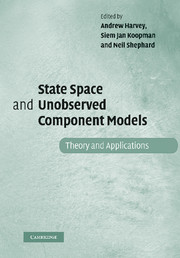Book contents
- Frontmatter
- Contents
- Preface
- Acknowledgements
- Part I State space models
- Part II Testing
- Part III Bayesian inference and bootstrap
- Part IV Applications
- 10 Measuring and forecasting financial variability using realised variance
- 11 Practical filtering for stochastic volatility models
- 12 On RegComponent time series models and their applications
- 13 State space modelling in macroeconomics and finance using SsfPackin S+Finmetrics
- 14 Finding genes in the human genome with hidden Markov models
- References
- Author index
- Subject index
13 - State space modelling in macroeconomics and finance using SsfPackin S+Finmetrics
Published online by Cambridge University Press: 06 January 2010
- Frontmatter
- Contents
- Preface
- Acknowledgements
- Part I State space models
- Part II Testing
- Part III Bayesian inference and bootstrap
- Part IV Applications
- 10 Measuring and forecasting financial variability using realised variance
- 11 Practical filtering for stochastic volatility models
- 12 On RegComponent time series models and their applications
- 13 State space modelling in macroeconomics and finance using SsfPackin S+Finmetrics
- 14 Finding genes in the human genome with hidden Markov models
- References
- Author index
- Subject index
Summary
Abstract
This article surveys some common state space models used in macroeconomics and finance and shows how to specify and estimate these models using the SsfPack library of algorithms implemented in the S−PLUS module S+FinMetrics. Examples include recursive regression models, time varying parameter models, exact autoregressive moving average models and calculation of the Beveridge–Nelson decomposition, unobserved components models, stochastic volatility models, and term structure models.
Introduction
The first version of SsfPack appeared in 1998 and was developed further during the years that the last author was working with Jim Durbin on their 2001 textbook on state space methods. The fact that SsfPack functions are now a part of the S−PLUS software is partly due to Jim Durbin. He convinced Doug Martin that SsfPack would be very beneficial to S−PLUS. Indeed the persuasive arguments of Jim Durbin has initiated the development of SsfPack functions for S−PLUS as part of the S+FinMetrics module. It is therefore an honour for us, the developers of SsfPack for S+FinMetrics, to contribute to this volume with the presentation of various applications in economics and finance that require the use of SsfPack for S+FinMetrics in empirical research.
State space modelling in economics and finance has become widespread over the last decade. Textbook treatments of state space models are given in Harvey (1989, 1993), Hamilton (1994), West and Harrison (1997), Kim and Nelson (1999), Shumway and Stoffer (2000), Durbin and Koopman (2001) and Chan (2002). However, until recently there has not been much flexible software for the statistical analysis of general models in state space form.
- Type
- Chapter
- Information
- State Space and Unobserved Component ModelsTheory and Applications, pp. 284 - 335Publisher: Cambridge University PressPrint publication year: 2004
- 3
- Cited by



